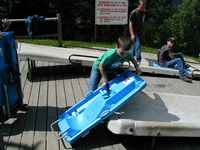
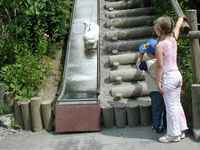
We love Italy. We love the food, the climate, the people, the history, in fact, just about everything. Though we have been there several times, there are still lots and lots of areas that we have never visited. One of these is the area known as Tuscany.
Tuscany is on the western coast of Italy and to north, just below where the *boot* flares out. This the is the land of glowing red hillsides, hilltop towns, and the home of the Renaissance. Many of the towns in this area have names familiar to everyone in Western culture: Florence, Sienna, and Pisa to name a few. Leonardo da Vinci called this home and Michelangelo did most of his great works here, in the land of white Carrara marble. There are also many, many small towns that just beg to be explored. So we did.
Being in the north and west of Italy, there are three approaches for getting there from Paris for those of us who are driving. One is to head south to the Mediterranean and turn right. Another is to take the "direct" route over the Alps. The third is to pass under the Alps using the Mont Blanc tunnel.
We chose the tunnel.
The Mont Blanc tunnel starts in the French town of Chamonix, passes under Mont Blanc (hence the name) for 20 kilometers, and comes out near the Italian town of Aosta. The drive from Paris to our rented house in Tuscany would make for a long day, so we split it into two parts, resting in Chamonix on the first night.
We have been to Chamonix several times, always in the summer and for the hiking. This time we took the opportunity to just play a bit. We went summer luging. So what is a summer luge? Well, it is just like a winter luge but in the summer. This requires a couple of small changes. Instead of ice, the course is a concrete run that rises and falls between banked curves. Instead of a sled with runners, the sleds have wheels and a joystick for controlling the brakes. These brakes are simple Teflon pads that are pressed into the surface of the track when you pull the joystick back for breaking. The harder you pull, the more you break.
To go luging, you buy your ticket and stand in line for a ski lift that takes you to the top of the run. There you pick up a sled. When it is your turn to go you set your sled on the track and climb on. This bit is always interesting as it is much like stepping into a row boat--you are always waiting to capsize. Once you are set, you pull yourself forward and let gravity do the rest. Great high-speed fun that is good for all ages.
Perri even had a chance to luge, but he used the slide in the playground instead. A bit shorter, perhaps, but just about his speed.


The tunnel is the longest tunnel in the Alps and has for years been used for heavy commercial transport, it being much cheaper and faster to go under the Alps instead of over. This all came to an end a few years ago when a truck caught on fire in the middle of the tunnel. The heat and fumes killed many people and destroyed the material of the tunnel. The repair required three years and was only completed a few short months before our trip.
The tunnel is a strange experience. Starting in France, you climb a winding mountain rode up to the entrance while looking over a snow capped mountain peaks. After driving past the thermal scanner and waiting your turn to enter, you then pass into a world of darkness that lasts for quite some time. When you come out the other side you are in the land of warm sun and grass covered hillsides--Italy. It sort of makes you feel like Dorothy and the trip to Oz, the change in color is almost that dramatic.
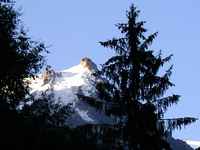
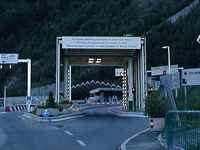
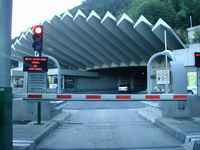
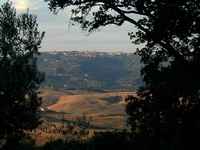
From the tunnel, we headed south towards the house that we had rented for the week. Halfway between the tunnel and the gite lies the city of Pisa. It seemed like a natural place to stop and take a quick break, so we did.
The famously leaning tower of Pisa is located in a large monument square, known as Piazza del Duomo, that includes the splendid cathedral (the Duomo) and baptistery for which the Tower is but a bell tower. The massive white constructions were stunning in the bright sun, shining above the neighboring towns.
Pisa was our first experience with the crowds, markets, and vendors of the tourist sites of Tuscany. Thankfully, the buildings were large and towering so that we could see them over the crowds and background noise. We also found that because of the heat, we could not leave Perri in the car. This kept us from climbing the tower or exploring the cathedral as dogs are not allowed and we did not want to become separated in the crowds. This was an important lesson for our subsequent visits around the countryside.
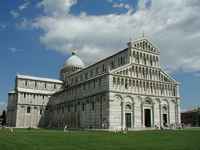
Once we got to our gite and got settled in, it was time to start exploring the neighborhood and the sites that make Tuscany famous. One of our first stops visits was the city of Florence.
When Rome fell it took the glory that was Rome with it, ushering in the period known as the Dark Ages. These long years ended with the birth of the Renaissance. The Renaissance, in turn, was born in Florence. The explosion of wealth, culture, and art has left an indelible impression on the city. History around every corner, a beautiful setting, and some of the most incredible museums in the world make Florence the focal point of any visit to Tuscany--or so the guide books would have you believe.
With such a reputation, every tour bus in Europe stops for at least a day, filling the waiting city (and vendors) to the gills. It is hard to enjoy a city when you are elbow to elbow in crowds and unable to breathe.
Having said that, Florence shines in the early morning before the buses arrive and the stalls open for business. The city is then quiet, yet alive with a majesty that has survived the ages. If you want to see the beauty that is Florence, do it early.
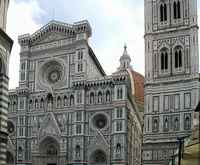
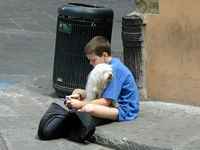
Volterra, located a hilltop just across the way from our gite, enchanted us with its beauty, history, and honesty. For Volterra knows what it does well and continues to do it in a way that makes you want to settle down and stay a while.
Volterra is the home of alabaster. The local hills yield the translucent stone that has been prized since before the Romans first became Romans and the art of turning these featureless lumps into works of beauty continues today in workshops scattered throughout the town. We enjoyed walking from shop to shop, admiring the many different products which can be made from alabaster. It was easy to see why alabaster from here has been delivered around the known world for centuries.
We also enjoyed the fact that Volterra is a town you could live in. In fact, this is where we went for groceries. It seems after so many years of fame with alabaster, the town has found an equilibrium between art and life, between hand made products of incredible beauty and hardware stores, between tourism and residents.
It is the perfection with which this town strikes this delicate balance that makes Volterra one of our fondest memories.
Fabrizio tells us that during the middle ages, the small towns survived by fortifying on the top of a hill and watching the larger cities (Pisa, Florence, Sienna, etc.) go to war in the valleys. To provide adequate warning of approaching hostilities, tall towers were built. They were also built by the wealthy families to show their power. In the case of San Gimignano, the tall towers were also used to dry the textiles which were the primary industry. With the wear and tear of the years, many of these towers no longer exist. One exception to this is the town of San Gimignano where several are still standing. Located opposite Volterra from our gite, San Gimignano is a historical walled town renowned for the towers and the otherworldly glow that they take in the setting summer sun.
Even though we a cloud covered sky dulled the glow, it was easy to see why this city is famous.
Halfway between Florence and Rome, there is another unique hill town, Pitigliano. Built on a very narrow spur, Pitigliano has been a fortified town for centuries and remains completely unspoiled. As we explored the narrow streets, residents sat out in the afternoon warmth swapping stories and watching the cats sleeping in the shade. Just about the right speed, I think. This was the last town in Tuscany that we visited and a very nice finish.
Of all that we saw, it was the countryside of Tuscany that stole our hearts. Perched on a hilltop and overlooking the surrounding farms, our rented home was a peaceful and scenic retreat from the bustle and crowds. It was from here that we could see the real beauty of the countryside. We did few things that were more pleasant or sublime than resting by the pool and watching the quiet hills glowing in the sun. Perfection!
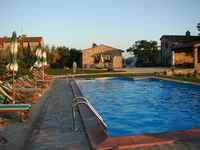
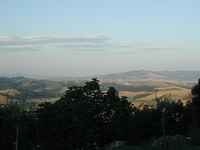
After a very quick week in Tuscany, it was time to start back home. We could have chosen to take the short route back through the tunnel but then we would have missed the opportunity to complete our collection of the small countries of Europe. By following the coastline back into France, we could add Monaco to our list of places we have visited while spending a few more days in the sun. Why not?
Following the coastline, we passed by Pisa and entered into another area made famous by rocks. Instead of alabaster, Carrara is famous for the pure white marble that bears its name. We climbed the hill and took a gander at one of the working open mines. As with any large industrial site, the size and power was amazing. To be honest, there was not much more there than that.
We stopped for the evening in Genoa, the last major Italian city before crossing over into France. Genoa is a city with a long industrial history that is trying to remake itself for the 21st century. The focal point of this is the waterfront where the docks have been completely redone into a new city center with shops, restaurants, and one of the largest aquariums in Europe and the world.
The aquarium really was impressive with large tanks that did a nice job of showing the many species that were on display. It also did a nice job of explaining just what it was you were looking at. The new riverfront area was also impressive with nice open spaces where it would be easy to spend a day just exploring and relaxing. If the rest of the city can be redone in this image, Genoa has a glowing future.
Passing from Genoa into Monaco, we headed for the center of this tiny country and the aquarium. Yes, two aquariums in two days. Each large, each historic, each special in their own ways. The Monaco aquarium is the oldest purpose-built aquarium in Europe and specializes in the rare and hard to keep fish. This is where to come if you want to see fish that only Jacque Cousteau and his camera men have seen. If you have the chance to visit, do not let the first couple of rooms dissuade you. This is a great aquarium.
The city itself impressed us with how clean, tidy, and Mediterranean it felt. The fact that we felt like singing "Duloc is a perfect place" should not be considered an insult. After the industrial squalor that is Genoa, the change was striking and appreciated.
Just over the border into France (therefore only about a mile from Italy) is the city of Nice, where we spent the evening. Nice is the capital of the Cote d'Azur, that stretch of beach culture made famous by the rich of Europe and the Cannes film festival. A beautiful city, Nice reminded us in many ways of Florida for their insistence that dogs did not belong at the beach. That is too bad as we would have liked to go swimming as a family. As it was, the kids went in for a few minutes but the surf was too high to be safe. We may have to give Nice another try and more time someday.
After a night in Nice, it was time to turn north and head home, passing through the area we had just visited the summer before. The beaches of Nice left us wanting one more good time in the water. But where to do this while heading inland? Studying the map, we realized that the Pont de Gard was on the way and would make a nice stop for lunch.
During our first visit to the Pont de Gard, we were surprised to see people swimming in the river beneath the bridge. We were also a bit chagrined as it was hot and steamy and our swimming trunks were back at the house. When we saw that with only a slight detour, we could make this a stop on our way home, we wasted no time and were rewarded with several restful hours beneath the warm sun in the cool and refreshing water. This filled our craving for one more "beach experience" and finished our trip on a warm and pleasant note.
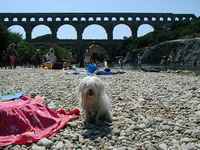
It would be easy to get caught up in the frustrations of the trip; rain, poorly marked roads, expensive meals, tourist traps and too many tourists, to name but a few, and to leave the impression that we did not have fun and that we no longer love Italy. This would be wrong though, for this trip reinforced just how much we do love Italy. The Italy of Volterra, the Italy of the Tuscan hills that glow in the sun, the Italy of real Italians. It was our fellow tourists that drove us crazy and made us wish that Tuscany had never been discovered by anyone other than us.
